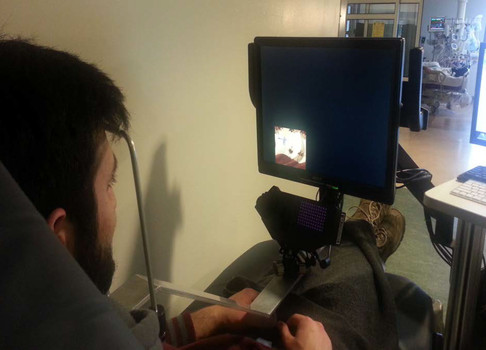Concussion experts and neuroscientists at the NYU Langone Medical Center say they are one step closer to detecting and measuring the severity of concussions through eye-tracking technology. The study was published in the Journal of Neurotrauma. The technology was designed to be a simple and objective diagnostic to detect concussions in the emergency room and in the future, on the sidelines of sporting events.
One of the primary indicators of a traumatic brain injury is the eyes rotating in opposite directions. Optometrists estimate that up to 90 percent of patients with blast injuries or concussions exhibit dysfunctional eye movements. Currently, a doctor will ask the patient to follow the doctor’s finger in order to determine the state of the eye.
“Concussion is a condition that has been plagued by the lack of an objective diagnostic tool which, in turn, has helped drive confusion and fears among those affected and their families,” says lead author Uzma Samadani, MD, PhD, assistant professor in the Departments of Neurosurgery, Psychiatry, Neuroscience and Physiology at NYU Langone. “Our new eye-tracking methodology may be the missing piece to help better diagnose concussion severity, enable testing of diagnostics and therapeutics, and help assess recovery, such as when a patient can safely return to work following a head injury.”
The research compared 75 patients with trauma that brought them to the emergency department at Bellevue Hospital Center in New York City and 64 healthy control participants. The participants, who were between the ages of 18 and 50 years, watched a video for more than 200 seconds. The researchers tracked and compared the movement of the participant’s pupils.
Among the trauma patients who had hit their heads, 13 had CT scans that showed new brain damage, and 39 had normal CT scans but had significantly less ability to coordinate eye movement than the uninjured participants. Most with normal CT scans were slightly worse at one to two weeks after the injury and recovered one month after the brain injury. The 23 trauma patients who had extremity or body injuries that did not require a CT head scan were able to coordinate their eye movement in a way similar to uninjured participants.
“Traumatic brain injury is one of the most common causes of neurologic morbidity in the world today,” Dr. Ellenbogen says. “Sports concussion, on the mild end of the spectrum of TBI, has captured the fascination of both the public and media. Since concussion affects all ages, both genders and occurs in all sports, being able to make the diagnosis quickly and accurately is essential. The challenge physicians have in identifying concussion is that the diagnosis is often based on self-reported symptoms.”








